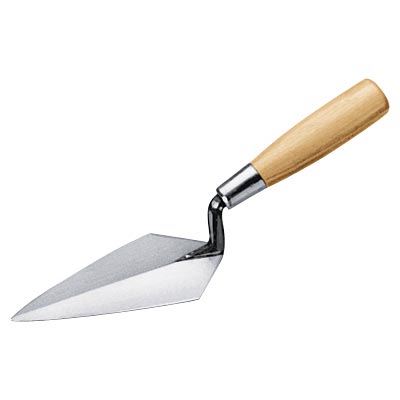
A good trowel is an indispensable gardening friend, with you through thick and thin for many years. Consider everything I say here, but definitely pick one that feels right to you when you hold and use it. As with shovels and spades, many different kinds of trowels are on the market. You have plenty of choices, so be sure to pay attention to the labels at the store and ask for assistance if you have trouble determining which trowel is right for you.
As you may have gathered if you read about shovels in the preceding section, good-quality materials make for a more effective, longer-lasting trowel. The blade (from cheapest on up to best) is made from
- Stamped metal
- Aluminum
- Forged carbon steel or (no rust!) stainless steel
Top-of-the-line trowels feature a carbon steel blade that’s epoxy-coated to resist wear and rust. As for the handle, good, strong wood is what you want —ash or hickory is best. Avoid cheap trowels of lightweight materials, because they seem to bend or even break at the slightest challenge. A sign of a quality trowel, one that can stand lots of use, is one whose wooden handle meets its metal blade in a strong and lasting manner so it won’t bend or break, of course. Cheap ones employ a simple tang-and-ferrule design. The ferrule is the circular clamp that holds the blade to the handle, and the tang, or shank, is the part of the blade extending into and usually through the ferrule. After a while, the ferrule tends to loosen and rattle around on the trowel’s shank.
This statement is not to criticize all tang-andferrule attachments; good, solidly anchored ones exist and are sometimes even reinforced with rivets. The alternative is a one-piece metal trowel. The one-piece metal trowels may send tiring shockwaves into your hands as you work and be icy cold to the touch, but clever manufacturers have solved this problem by coating the handle with rubber or PVC plastic. For other types, seek a smooth wooden handle so you don’t get splinters or blisters. In any event, you should be able to squeeze the handle comfortably, with little stress to your wrist.
Some trowels have a hole drilled into the very top part of the handle, perhaps with a string or leather thong loop for hanging and storing the tool when it’s not in use. Though this feature may seem frivolous, it can be a handy extra if you’re the sort of person who needs to be reminded to bring your gardening tools indoors and clean them up after use. Another feature you may appreciate is a ruler stamped or etched into the blade — built-in rulers are helpful when you’re planting various sorts of bulbs or other flowers that require varying planting depths.
This statement is not to criticize all tang-andferrule attachments; good, solidly anchored ones exist and are sometimes even reinforced with rivets. The alternative is a one-piece metal trowel. The one-piece metal trowels may send tiring shockwaves into your hands as you work and be icy cold to the touch, but clever manufacturers have solved this problem by coating the handle with rubber or PVC plastic. For other types, seek a smooth wooden handle so you don’t get splinters or blisters. In any event, you should be able to squeeze the handle comfortably, with little stress to your wrist.
Some trowels have a hole drilled into the very top part of the handle, perhaps with a string or leather thong loop for hanging and storing the tool when it’s not in use. Though this feature may seem frivolous, it can be a handy extra if you’re the sort of person who needs to be reminded to bring your gardening tools indoors and clean them up after use. Another feature you may appreciate is a ruler stamped or etched into the blade — built-in rulers are helpful when you’re planting various sorts of bulbs or other flowers that require varying planting depths.

No comments:
Post a Comment